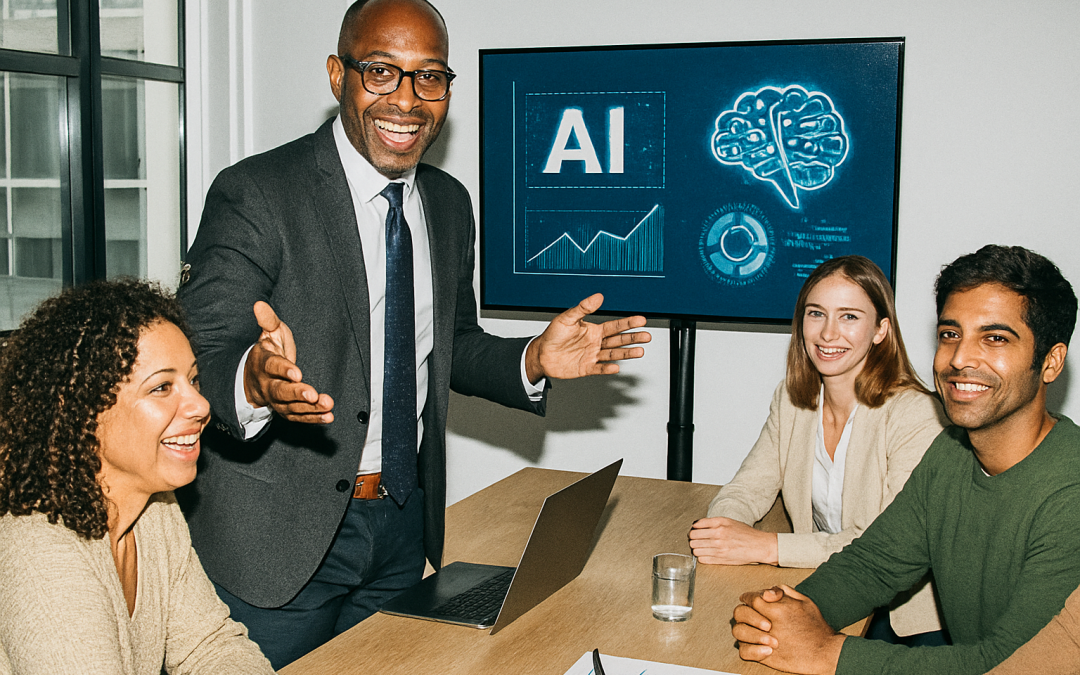Integrating Artificial Intelligence (AI) into the workplace is both an exciting and scary proposition. It’s one of the most common topics we discuss with our leadership coaching clients. “How do we do it right?” they ask.
Understanding how to harness this technology’s power can provide organizations with meaningful and transformational competitive advantages. McKinsey estimates that the long-term AI opportunity is valued at about $4.4 trillion in added productivity growth potential from corporate use cases. Read that again: $4.4 trillion in added productivity growth potential! Who wouldn’t want to harness that? However, the key to achieving transformational triumph primarily lies in leadership’s ability to envision success through collaboration between humans and AI.
Leaders, by nature, are used to advancing (mostly) fearlessly to avoid setbacks and remain competitive in the future. History has shown us that periods of major economic and technological shifts define the success or failure of companies. Harvard Business School professor Karim Lakhani said, “AI won’t replace humans, but humans with AI will replace humans without AI.”
Leaders must foster a culture that celebrates AI’s potential, not with a fear of losing human capital but rather with the confidence that the use of AI will complement human capabilities and potential.
If your organization needs support with leadership development or adapting culture, Crosworks can help. We work with organizations of all sizes and industries. We’ll tailor a program to fit your unique, current needs. Schedule a free call to learn more.
The Current Landscape
The use of AI is no longer a luxury but rather a necessity. Across various industries, we are witnessing that these transformational tools are being successfully integrated into established programs, enhancing and supercharging their capabilities far beyond our imagination.
The shift toward AI integration is accelerating rapidly. Data from the 2025 Talent Trends Report by the Society for Human Resource Management (SHRM) reveals that 43% of organizations now leverage AI in HR tasks, showing a drastic increase from just 26% in the previous year. However, despite its growing acceptance and use, a large number of employees report that their organizations have not been proactive in training them to work alongside AI technologies – a critical gap that HR leaders must address promptly.
Integrating AI into the workplace is anything but simple. Fear and uncertainty are abundant; workers are concerned with what will unfold in the future. To clear the air of uncertainty and reluctance, here are some ways that leaders can mindfully integrate AI into the workplace.
Educate and Demystify
It’s natural for employees to feel fearful and uncertain about how AI will impact their roles in the future. That’s why educating and demystifying AI is extremely important. Start by holding educational training and workshops to give workers an understanding of how the use of AI can help them carry out their day-to-day tasks more efficiently. By fostering a culture that welcomes openness and communication, you can effectively address concerns and fears by helping employees understand that AI tools will augment their potential rather than replace their skills.
Slack-integrated AI Bots and Microsoft Teams’ AI features are transforming how we communicate and collaborate with employees and businesses. These systems are designed to provide smart suggestions, automate regular tasks and enhance team interaction experiences.
Cultivate an AI-Partner Mindset
Creating comfort around AI as a crucial element for improving productivity and potential is key. One strategy to build acceptance is to encourage experimentation, so employees become more proficient over time and discover unique ways to modify and improve their day-to-day tasks. For example, the HR and finance enterprise AI platform Workday is empowering recruiters to take on the role of strategic advisors by allowing them to focus on smoother, quicker and more informed processes.
Invest in Employee Training
Leaders must proactively train employees on AI’s capabilities and limitations. Ample training opportunities provide clear guidance, prevent underutilization, eliminate user frustration and protect employees–and ultimately the organization–against any security vulnerabilities. Here are a few practical ways to build your team’s AI fluency:
- Create an educational path, one that begins with foundational awareness and leads to applied fluency.
- Ensure that your programs are tailored to suit different roles and functions in the organization.
- Allow the use of simulations and hands-on training to increase understanding and opportunities to work on real workflows.
- Implement training as continuous learning rather than one-time programs.
- Listen, accept feedback and evaluate at set intervals. How are employees coping? What are areas that require further guidance and training?
Key Takeaways
Though it seems clear that organizations with an AI-first approach will outshine their competitors, success will be felt in how an organization transitions to AI integration. It requires a thoughtful process to recognize fear and uncertainty, create awareness, offer simulations and ongoing training, and support a culture that unites human potential with AI abilities.
With its people-first approach, Crosworks specializes in being a non-biased partner to an organization and understanding what you’re trying to achieve. Whether it’s developing and shifting culture, supporting leaders or maximizing the potential of a team, we can tailor a program to fit your needs. Schedule a free call to learn how we can help your organization.
